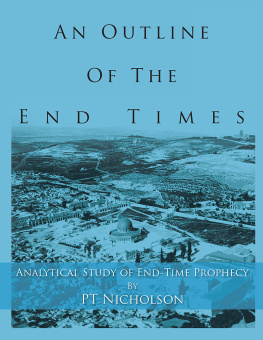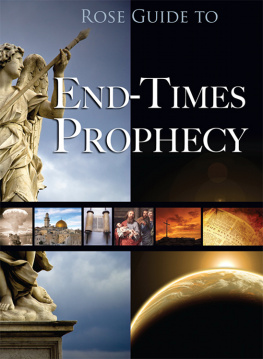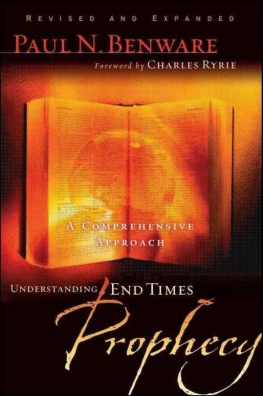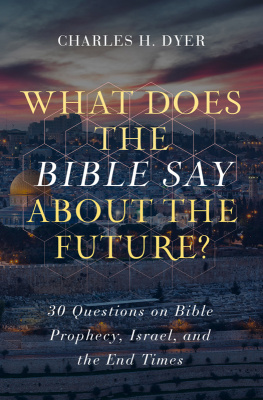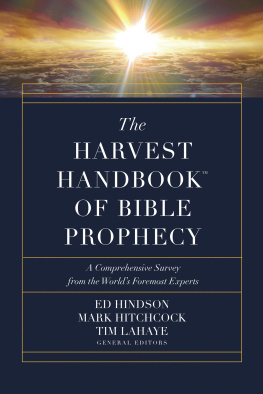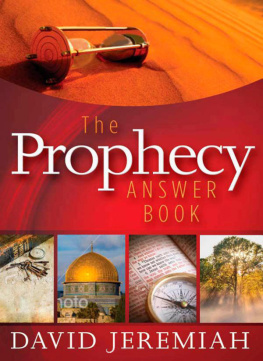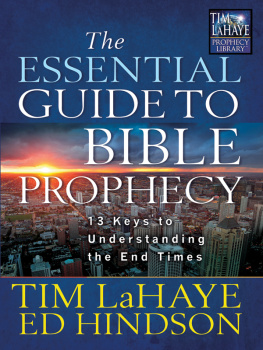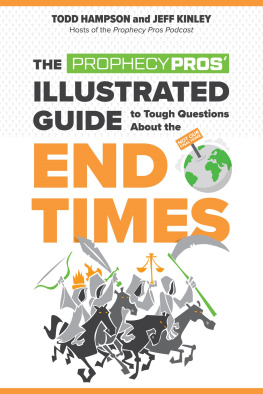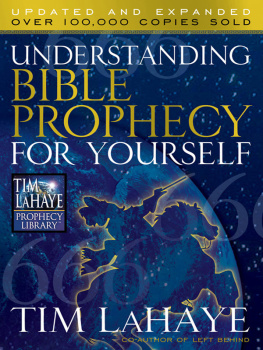An Outline of the End Times
Analytical Study of End-Time Prophecy
PT Nicholson
Copyright 2017 PT Nicholson. All rights reserved.
ISBN
978-1-4828-6174-7 (sc)
978-1-4828-6173-0 (e)
All rights reserved. No part of this book may be used or reproduced by any means, graphic, electronic, or mechanical, including photocopying, recording, taping or by any information storage retrieval system without the written permission of the publisher except in the case of brief quotations embodied in critical articles and reviews.
Because of the dynamic nature of the Internet, any web addresses or links contained in this book may have changed since publication and may no longer be valid. The views expressed in this work are solely those of the author and do not necessarily reflect the views of the publisher, and the publisher hereby disclaims any responsibility for them.
www.partridgepublishing.com/africa
12/14/2016

Unless otherwise noted, Scripture quotations are taken from the Holy Bible, New International Version, NIV Copyright 1973, 1978, 1984, 2011 by Biblica, Inc.TM Used by permission. All rights reserved worldwide.
Scripture quotations marked (KJV) are taken from The Authorized (King James) Version. Rights in the Authorized Version in the United Kingdom are vested in the Crown. Reproduced by permission of the Crowns patentee, Cambridge University Press. First published in 1611.
Scripture quotations marked (NKJV) are taken from the New King James Version. Copyright 1982 by Thomas Nelson. Used by permission. All rights reserved.
Scripture quotations marked (ASV) are taken from the American Standard Version which is in the public domain as it was published in 1901.
Scripture quotations marked (NASB) are taken from the NEW AMERICAN STANDARD BIBLE, Copyright
1960,1962,1963,1968,1971,1972,1973,1975,1977,1995 by The Lockman Foundation. Used by permission.
Scripture quotations marked (NLT) are taken from the Holy Bible, New Living Translation, copyright 1996, 2004, 2007 by Tyndale House Foundation. Used by permission of Tyndale House Publishers, Inc., Carol Stream, Illinois 60188. All rights reserved.
Scripture quotations marked (ESV) are taken from the ESV Bible (The Holy Bible, English Standard Version), copyright 2001 by Crossway, a publishing ministry of Good News Publishers. Used by permission. All rights reserved.
Published by Partridge Africa, United States of America.
Sources of pictures:
Cover photograph: View of the Temple Mount from the Western Wall (about 1928) - National Council of Young Israel New York
Figure 9: The Temple Mount in Jerusalem Jim Millegan, Lambert Dolphin and Michael Kollen www.templemount.org
Contents
Figures
Tables
This book is dedicated to the memory of my father, KT Nicholson, who was a true saint.
Foreword
Why would the author of an End-Times book espousing a premillennial post-Tribulation Rapture viewpoint ask an amillennialist to write the foreword to his book? There can only be one answer: grace! That is a rare virtue, seldom found in the field of biblical prophecy studies. Those who write on End-Time events are usually known for their uncompromising dogmatism: they are right; everyone else is wrong.
Mr Nicholson is careful to pre-empt the accusation of arrogant dogmatism: he is, as he states in his epilogue, careful not to postulate future outcomes as fact, but as likely scenarios. It is appropriate for authors on this subject to implicitly state that they may be wrong on the details. His final paragraph is equally irenic. He gives practical guidelines on how to select books on the End Times that will be likewise helpful, and how to recognise (and avoid) others. He argues his case well, but graciously. Grace pervades this book. His convictions are confident, but never arrogant. That alone makes this book worth reading, even by those who might not agree with him.
Mr Nicholson demonstrates a wide understanding of competing interpretations. He analyses these carefully, honestly facing up to their valid critiques of the view he holds. Scattered throughout his book are tabulations of Arguments for and Arguments against. These enable readers to think for themselves, as he avoids force-feeding his view.
He supplies an impressive index of Scriptures cited in the book. Such a comprehensive survey of the whole Bible adds value-depth to his teaching. He warns against basing an End-Time study on only one book, for example Revelation. The reader will evaluate whether his interpretations and applications are always valid, and whether they should be explained literally or symbolically. (For example, in the chapter The Third and Fourth Jewish Temple he applies Is 40:4 literally to the End Times, whereas Lk 3:5 applies it symbolically to the ministry of John the Baptiser.)
This book will hold the readers attention to the very end. It is the best presentation of the premillennial post-Tribulation Rapture position I have ever read. I have found it fascinating. The vast wealth of material is presented in a clear and well-organised manner. The charts and maps capture the text in a memorable way. It is well-referenced from a wide reservoir of sources.
Who will be the antichrist? Previous candidates for the role of Antichrist have been the Roman Emperor, the Pope, and Hitler. In their time, the supporting arguments have all seemed convincing. With historical hindsight we now know they were wrong. The writer makes a convincing case for a Muslim antichrist. He has personally lived in the land of Magog (Turkey), the Last Empire of Daniels vision. As one who is cognisant of the current trends in Islam under Muslim control, this gives an experiential authenticity to his analysis.
This book would probably have converted me to the writers prophetic viewpoint, if it were not for the following chief considerations: Firstly, our Lord taught that His Return is imminent; that it could take place at any moment. A post-Tribulation Rapture implies we will have a 7-year, or a 42-month, advance warning of His coming. Secondly, the insistence on a literal fulfillment of prophecies such as Jer 33:17-18 allows for animal sacrifices after Christs once-for-all sacrifice on the cross. This seems retrogressive, in spite of his justifying it.
But do not take my word for it. This book invites avid reading, a healthy curiosity, critical study, and prayerful application. The reader who works through its pages with an open Bible, and a pencil in hand, will be edified. The boundaries of knowledge and insight will be widened and deepened by the time its final chapter is absorbed.
Mr Nicholson demonstrates a constant awareness of other systems of interpreting the Bibles prophecies about the future, and which are referred to throughout the book. Whatever the readers own End-Time matrix, he or she will be lovingly challenged to re-examine its rationale. This is a spiritually healthy exercise, and one which has enriched me as Ive done so. My longing for Christs Return intensifies.
Rev Hugh G Wetmore
Former pastor and founding General Secretary: Evangelical Fellowship of South Africa,
Pietermaritzburg
Some of the few books that I have read on the End Times (and there are many) sadly do not do justice to such a complex subject as prophecies on the End Times. Conclusions drawn appear to be from selective interpretation of texts to support a particular position; that is, taking texts out of their originally intended meaning, rather than an exhaustive analysis of prophetic texts in their proper context. This is not to say that it is a straightforward exercise, else there would not be such divergent views amongst evangelical Christians. Indeed, creating a coherent picture of how the End Times will unfold is probably the most complex task for a serious student of the Bible: many events are foretold piecemeal in numerous texts, across different authors, different eras, different contexts, in different forms (including symbolism, in non-chronological order, many double-prophecies already fulfilled and yet to be fulfilled), all written within a culture and time-frame far removed from our own. Moreover, translations from the original may distort the accuracy of certain texts. The task is not made any easier by subtle personal biases influenced by theological teaching, doctrinal position, denominational affiliation, level of knowledge of the Scriptures and even personality (left-brain or right-brain domination).
Next page
